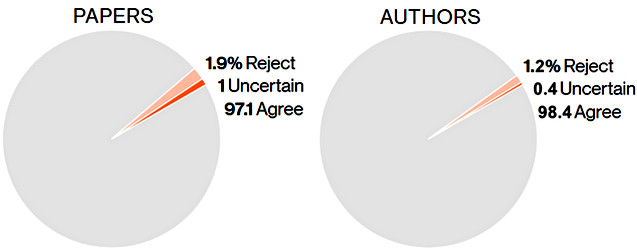It’s not a myth, hoax or a conspiracy among scientists. As we argue about the path we take, let’s recall the facts that compel the journey.
1. The world is getting warmer.
Earth’s temperature goes up and down from year to year — but over the past half century it has gone up a lot.
Global temperature, difference from 20th century average, in degrees Fahrenheit |
| SOURCE: NOAA |
The heat in 2016 broke the historic record set in 2015, which broke the one from 2014. Last year’s average global surface temperature, compiled from measurements made by thousands of weather stations, buoys, and ships, was 1.69 degrees Fahrenheit warmer than the 20th-century average.
Satellites probing the atmosphere also have documented a clear warming trend.
2. It’s because of us.
Carbon dioxide warms the planet, and we’ve increased the amount in the air by nearly half, mostly since the 1960s.
Atmospheric carbon dioxide, 1800-2016, in parts per million |
| SOURCES: NOAA, Carbon Dioxide Information Analysis Center |
Only CO2 and other human-emitted greenhouse gases have gone steadily up, forming a thickening blanket that traps heat at the Earth’s surface.
3. We’re sure.
More than nine out of 10 climate scientists agree: Our carbon emissions are the main cause of global warming.
But it’s real, and it’s dangerous.
Arctic sea ice is shrinking, and glaciers are retreating worldwide. Seas could rise three feet by 2100—or maybe more.
Extent of Arctic ice, September average, millions of square miles |
| SOURCE: National Snow and Ice Data Center |
That loss speeds the warming, as sunlight is absorbed by dark ocean instead of reflected into space by ice.
Melting sea ice doesn’t raise sea level—it’s already in the water—but melting land ice does. Mountain glaciers are in global retreat. The total sea level rise of eight or nine inches since 1900 has contributed to a sharp increase in flooding along coasts. During Superstorm Sandy, for example, floods and winds caused $68 billion in damage on the U.S. East Coast.
The big threat is the ice sheets covering Greenland and Antarctica. They hold enough ice to raise seas more than 200 feet—and they’re losing it.
When Earth was just a bit warmer, 125,000 years ago, they seem to have lost a lot: Sea levels were 20 to 30 feet higher. Such a rise today would swamp coastal cities.
5.Weather is wreaking havoc.
Worldwide, the number of climate-related disasters has more than tripled since 1980.
 |
| SOURCE: Munich RE Natcatservice |
The extraordinary heat wave that killed some 70,000 people in Europe in 2003 should have been a once-in-500-years event; at the current level of global warming, it has become a once-in-40-years event, according to a study published last year. In Paris alone, that analysis found, climate change caused 506 excess deaths in 2003.
If it continues unchecked, another recent study said, by late this century people living along the Persian Gulf may face many days so hot that it will be unsafe to go outside.
It’s not just the heat: Global warming adds moisture to the air, removing it from land and ocean. Where rain is lacking, it makes the drought worse. When rain or snow falls, it’s more likely to be extreme; think of the 2016 floods in Paris or Houston.
How climate change affects hurricanes and other tropical cyclones is less certain. But by heating the ocean—the storms’ energy source—it’s likely to make them more intense, if less frequent.
6.Species are being disrupted.
Animals and plants are already vanishing from parts of their range that are now too hot. Extinctions come next.
Ice loss is forcing walruses by the thousands onto land in Alaska. Entire regions are being transformed: Alpine ecosystems from the Rockies to the Swiss Alps are being squeezed off mountaintops. The exceptional ocean warmth of the past few years has triggered coral bleaching and die-offs at reefs around the world.
There will be winners. For now, humpback whales are thriving in newly ice-free waters off Antarctica. Sea urchins too are proving to be resilient. But climate change isn’t the only threat that spreading human populations impose on other species; we’re also fragmenting and destroying natural habitats.
Some species will adapt to the jarring changes in their world—but how many, and for how long?
7. We can do something about it.
Renewables, the fastest-growing energy source, are projected to triple by 2040.
 |
| SOURCES: EIA, Bloomberg New Energy Finance |
Though shadowed by the new U.S. administration’s threat to withdraw from it, the agreement stands as one hopeful sign. The graph below, right, shows another: The cost of solar energy is plummeting. Even without a carbon tax—the most efficient way to wean an economy off fossil fuels—renewables soon may be cheaper sources of electricity.
Worldwide, they accounted for more than half the new generating capacity in 2015. In the U.S., solar now employs more people than coal, oil, and gas combined.
The switch from fossil fuels is still just beginning. Every little bit matters: Every ton of CO² we emit melts 32 square feet of Arctic ice, according to a 2016 study, which means the average American melts 525 square feet a year.
Every energy-saving building, retired gas-guzzler, and acre of preserved forest helps. But none of it will help much if the world doesn’t switch to a carbon-free energy supply soon.
Links
- ‘A Tsunami In The Sky’: Climate Change Is Melting Bhutan’s Glaciers And The Danger Is Real
- How Much Will The Planet Warm If Carbon Dioxide Levels Double?
- Sensitive Planet: Scientists Narrow The Expected Heating From CO2 Rise
- Major New Climate Study Rules Out Less Severe Global Warming Scenarios
- Pandemic Shows Climate Has Never Been Treated As Crisis, Say Scientists
- Climate Change: Siberian Heatwave 'Clear Evidence' Of Warming
- Larger Waves In Store As The Planet Warms
- Experts Issue Dire Warning That Rising Temperatures May Exceed Crucial Threshold Within 5 Years




No comments:
Post a Comment